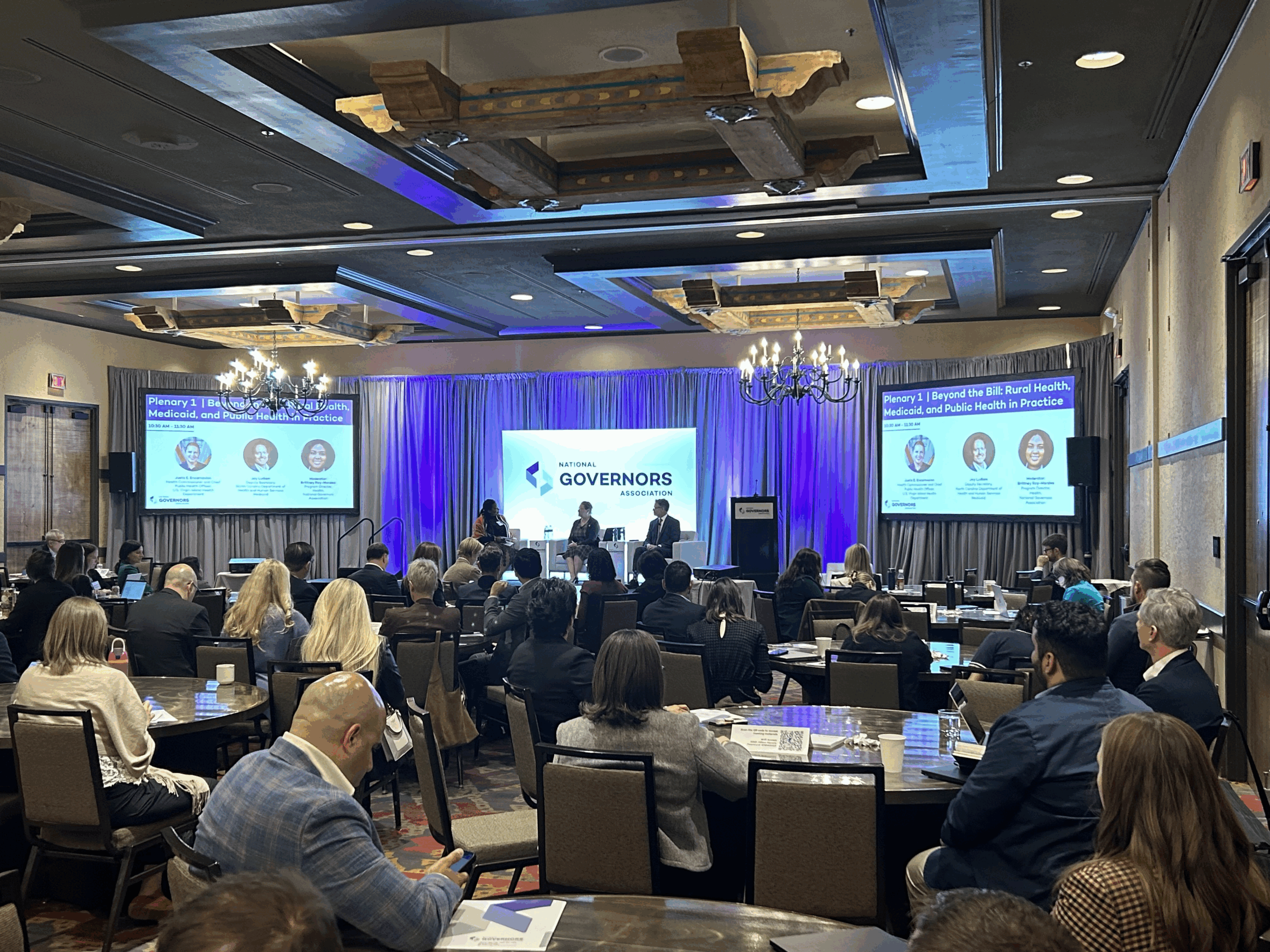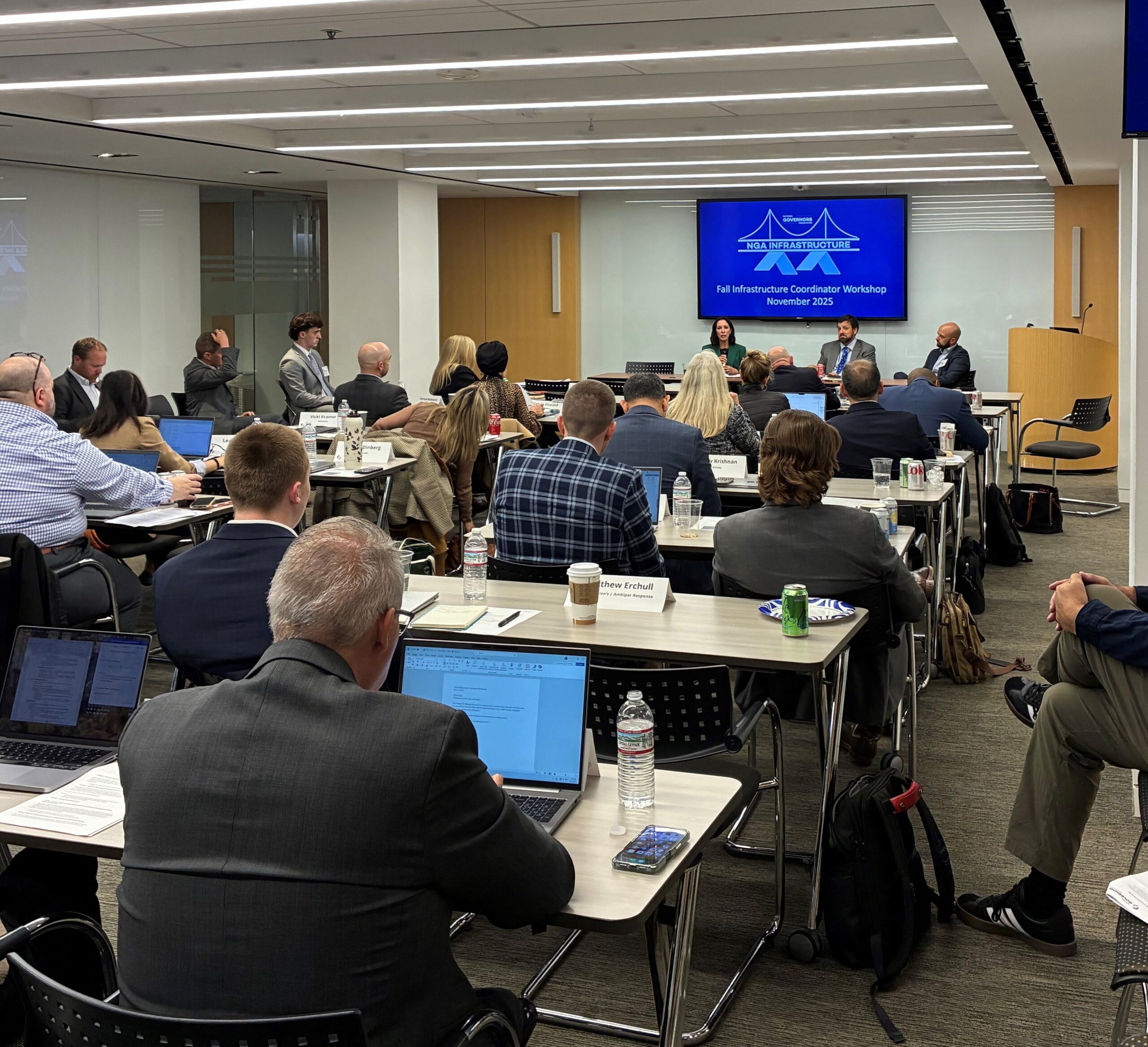The National Governors Association (NGA) held the 2025 Governors’ Advisors Energy Policy Institute in Boston, Massachusetts, October 7-8. The annual Energy Policy Institute convened Governors’ energy policy advisors and senior staff from across the country alongside experts, private-sector practitioners, and NGA partners to discuss the most pressing challenges and opportunities facing states and territories. More than 100 attendees, including Governors’ advisors from 26 states and territories, attended the Energy Policy Institute.
The two-day event covered a broad array of topics, including major trends in the energy industry, aligning energy and economic development, state nuclear energy initiatives, meeting energy security threats, demand-side solutions, and regional collaboration for energy planning. Through a series of keynote addresses, expert-led panels and roundtable discussions, attendees grappled with the most significant energy challenges facing their state or territory. State and territory attendees were also given the opportunity to hear about their fellow colleagues’ recent accomplishments, ongoing priorities, and growing challenges during the state and territory-only discussion that took place the morning of October 7. In addition to formal programming, attendees were invited to network and get to know their peers at a welcome reception on the first night of the event. NGA thanks our partner Schneider Electric for their generous support of this reception.
Energy Leadership from Our Hosts, The State of Massachusetts

On October 8, Massachusetts Governor Maura Healey joined Energy Policy Institute participants to share her insights on the path being charted in Massachusetts to ensure reliable and affordable energy. Governor Healey emphasized her all-of-the-above strategy to bring more energy into Massachusetts and meet rising demand. Following Governor Healey’s remarks, attendees heard from Massachusetts Secretary of the Executive Office of Energy and Environmental Affairs Rebecca Tepper. Secretary Tepper elaborated further on the strategies that Massachusetts is employing to make energy more affordable to consumers and increase energy production.
Highlights From the Energy Policy Institute
Keynote Remarks by FERC Commissioner Judy W. Chang
The program launched with expert remarks from Federal Energy Regulatory Commissioner (FERC) Judy W. Chang. Commissioner Chang emphasized the importance of clear, informed state engagement in shaping energy markets and transmission policy. The Commissioner also shared her appreciation for state perspectives, noting that the more context FERC has about state interests and motivations, the better positioned the commission is to weigh them alongside legal precedent and broader regulatory considerations. Her remarks demonstrated a collaborative perspective on how federal and state entities can work together in energy governance.
State of the Market: 2025 Energy Trends

The U.S. is facing its highest power demand growth since the 1940s-1950s, driven in part by a large surge in data center development. To set the stage on how the U.S. is approaching this demand growth, Kate Hardin, Executive Director of Energy, Resources, and Industrials Research at Deloitte, gave a presentation on the major energy, economic, market and technology trends. One trend includes the increase in data center driven natural gas demand through 2030 which could range from 3 to 12 billion cubic feet per day, driven by a growing number of planned gas power plants. Nuclear energy is also re-emerging as a longer-term solution and could address at least 10% of the increased electricity demand being seen.
A convergence of energy demand, fuels, and technologies such as artificial intelligence (AI) for energy, grid-enhancing technologies (GETs), and automation are reshaping the power sector. The uncertainty in projected load growth, due to cloud and AI demand, is raising risks and costs, making demand management and load flexibility important to future planning.
Energy as an Economic Driver for AI, Manufacturing, and More
As artificial intelligence (AI), advanced manufacturing and data-driven technologies surge, so does the demand for reliable, scalable energy infrastructure. This panel of experts, which included both state and industry perspectives, dove into how states and territories can position energy as a driver for economic development, meeting the rising load from data centers and AI while fostering industrial growth. Attendees heard from Mark Silberg, Energy Policy Advisor with the Office of Colorado Governor Jared Polis; Mike Fradette, Principle of Energy Strategy at Amazon Web Services; and Jennie Nevin, Associate Partner of Public Sector, Energy, and Infrastructure Practices at McKinsey. The speakers underscored the importance of treating energy as a central pillar of economic competitiveness in an AI-driven future. Governors can foster early coordination between energy planning and economic development to inform investments and ensure economies maintain robust growth while mitigating impacts to grid reliability and rates.
Nuclear Energy: State Actions and Initiatives
As states explore how to meet significant load growth, new nuclear energy is emerging as a potential solution. This year, NGA hosted a slate of nuclear in-state retreats for seven state teams aimed to advance Governors’ nuclear energy policy. Attendees heard from Kurt Schaefer, Director of the Missouri Department of Natural Resources; Jon Ford, Executive Director of the Indiana Office of Energy Development; Stephen Swiber, Deputy Secretary of the Louisiana Department of Energy and Natural Resources; and Jeff Semancik, Division Director of the Connecticut Department of Energy and Environmental Protection, on behalf of the New England cohort team. The four speakers shared the outcomes of their retreats, lessons learned, and where their state is headed now regarding nuclear energy. Each state has a different focus for their project with NGA, including how to align the economic development and energy sector to advance nuclear projects, how to incentivize financing of large nuclear projects, how to communicate the advantages of nuclear and what the role is for state government in bolstering the nuclear energy sector. This session provided insight to attendees on how other states are exploring and talking about the use of new nuclear energy.
State Energy Security Briefing
As threats to the security of the energy system are multiplying and growing more sophisticated, Governors and their staff play a critical role in securing the system through both their own actions and through partnerships with private sector operators. To highlight the emerging energy security threats to systems, Brian Harrell, VP and Chief Security Officer of Avangrid, and Kimberly Denbow, Vice President of Security and Operations at the American Gas Association (AGA) provided an unclassified threat briefing to attendees. This briefing included detailed discussions of cyber and physical incidents that are impacting the energy sector.
State Leadership to Meet Emerging Energy Security Threats
Building off the energy security threat briefing, Paul Holloway, Senior Energy Security and Resilience Lead at the Massachusetts Department of Energy Resources, and Travis Kellerman, Senior Climate Policy Advisor with the Office of New Mexico Governor Michelle Lujan Grisham, explored state policies and actions to address two emerging threats: cybersecurity and wildfires.
Holloway emphasized that as the grid becomes more automated and interconnected, it also becomes more vulnerable cyberattacks – particularly targeting generation, transmission, and distribution assets. Massachusetts has developed a robust cybersecurity resilience network, including regular coordination with the public utilities commission (PUC), industry partners and the state’s fusion center for secure information sharing. Holloway also emphasized the lessons learned from exercises like GridEx-VIII and the development of the State Energy Security Plan (SESP), which highlighted the importance of knowing who to contact and how to respond in a crisis.
Kellerman highlighted how New Mexico views wildfires as a systemic energy risk and is taking proactive steps through legislation like the Wildfire Prepared Act. This legislation includes funding for home hardening, protecting critical infrastructure and collaborating with tribal nations using traditional ecological knowledge. He stressed the importance of prevention over response, noting innovative mitigation strategies like cloud seeding and maintaining irrigation networks. A key message was shared that investment in wildfire mitigation not only reduces systemic risk but also creates long-term economic and social benefits.
Meeting Growth Through Demand-Side and Behind-the-Meter Resources
Demand-side and behind-the-meter resources are increasingly becoming strategic assets within modern energy systems. To discuss this development, attendees heard from a panel of experts including Jenifer French, Chair of the Ohio Public Utilities Commission; Rachel Wilson, Southeast Energy Market Lead at Google; Michael Wheeler, Vice President of Government Affairs and Intersect Power; and Jeannie Salo, Chief Public Policy Officer at Schneider Electric.
As electricity load increases, states are looking for near-term solutions to meet this growth while they continue exploring more systematic investments in generation and transmission. These speakers discussed two potential near-term solutions for data centers and manufacturers: demand response to enable peak shaving and power generation co-located with new large loads. While automation and smart infrastructure can enable flexible load and resilience, scaling these capabilities will require significant policy support and investment. The speakers discussed examples of public-private collaboration to meet the dual challenge of rising electricity demand and the race for AI-driven infrastructure.
Investments in Energy Infrastructure in a Dynamic Power Market
As the energy landscape continues to evolve, state leaders are facing mounting pressure to ensure reliable and affordable power. Rapid shifts in technology, regulatory frameworks, market structures and consumer demand are fundamentally reshaping the economics of electricity generation. To contextualize how states and territories can enable strategic investments, participants heard from Dan Pugliese, Investment Director at Meridiam, and Will Sauer, Vice President of Federal Regulatory Affairs at Exelon.
Dan Pugliese highlighted Meridiam’s global investment approach – building, owning and operating infrastructure – with a focus on community benefit and long-term value. Will Sauer, representing the largest utility in the U.S. by customer count, emphasized the critical need of regulatory frameworks that ensure both supply reliability and cost effectiveness. Both speakers stressed that even in the absence of recent load growth, significant infrastructure gaps exist. Current conditions have created opportunities for private-public partnerships, and clear, consistent state policies, supportive legislation for P3s and internal advocates within government to champion major projects are crucial.
Regional Gubernatorial Collaboration for Energy Planning
In a session on regional gubernatorial collaboration for energy planning, state leaders from Massachusetts, New Hampshire, Pennsylvania, and Virginia emphasized the growing importance of cross-state collaboration to address regional energy challenges and transmission needs. Weezie Naura, Deputy Secretary for Federal and Regional Energy Affairs at the MA Executive Office of Energy and Environmental Affairs, and Daniel Phelan, Regional Policy Director at the New Hampshire Department of Energy, discussed the partnership convened through the New England States Committee on Electricity (NESCOE).
Through NESCOE, the states have achieved significant progress, such as a multi-state request for proposals to unlock 1,200 MW of onshore wind in northern Maine. Jacob Finkel, Deputy Secretary of Policy with the Office of Pennsylvania Governor Josh Shapiro, and Glenn Davis, Director of the Virginia Department of Energy, shared their experiences as states within the PJM Interconnection (PJM) region. They emphasized the point that Governors’ office engagement is crucial to improving PJM processes and structures, citing outdated governance structures as a challenge. A key takeaway from this session was that sustained regional collaboration, even when state policies do not necessarily align, is crucial to addressing shared energy needs.
The 2025 Governors’ Advisors Energy Policy Institute was co-located this year with the States Transmission Summit which took place October 9. To learn more about this event, see the Transmission Summit Readout.
Energy is essential to modern life, and Governors are actively working to keep energy affordable and reliable while meeting emerging load growth challenges. The NGA Center’s Energy team will continue to provide support to Governors and their energy policy advisors on these and other timely challenges. For questions or requests for technical assistance, please reach out to Dan Lauf (dlauf@nga.org) and Chris Fletcher (cfletcher@nga.org).












